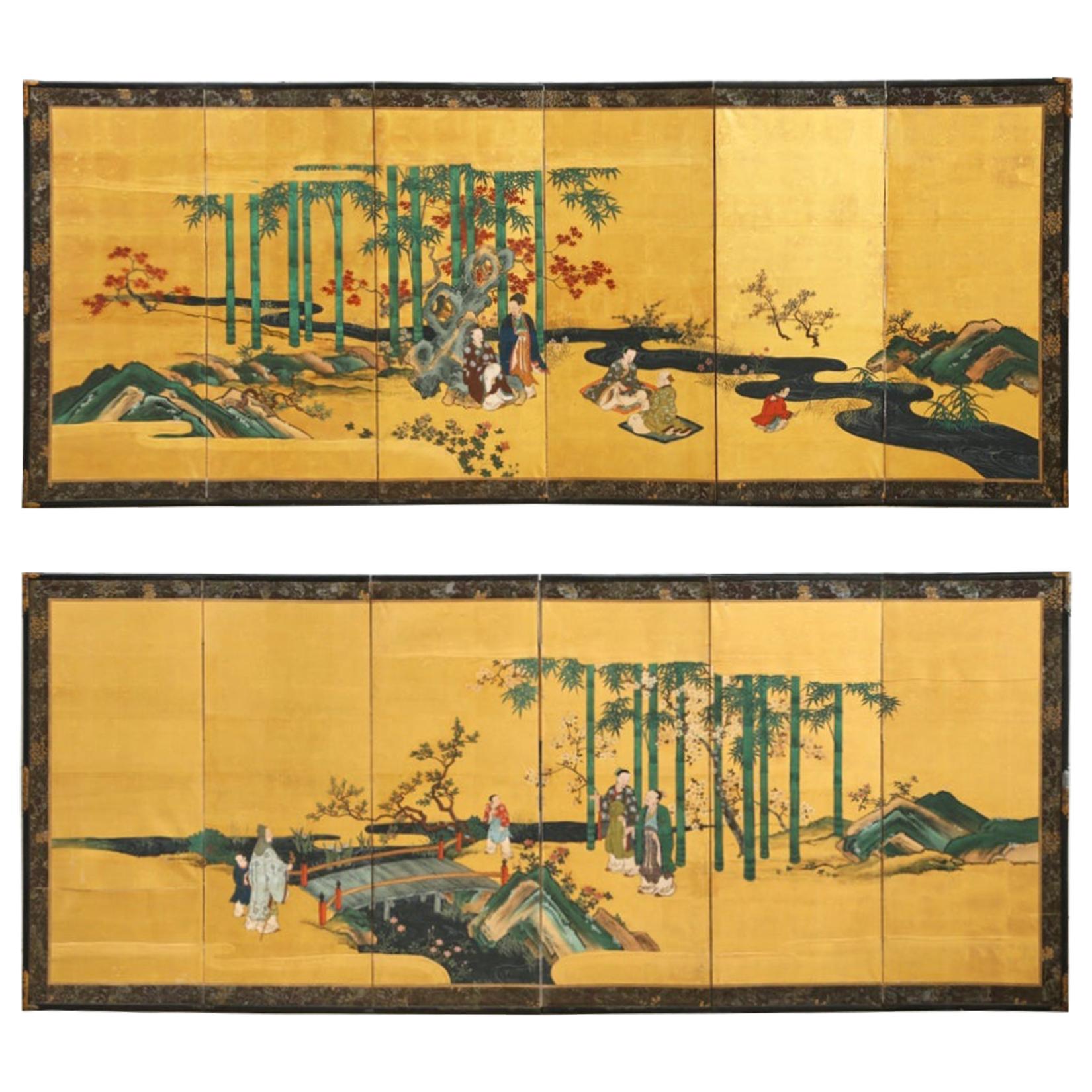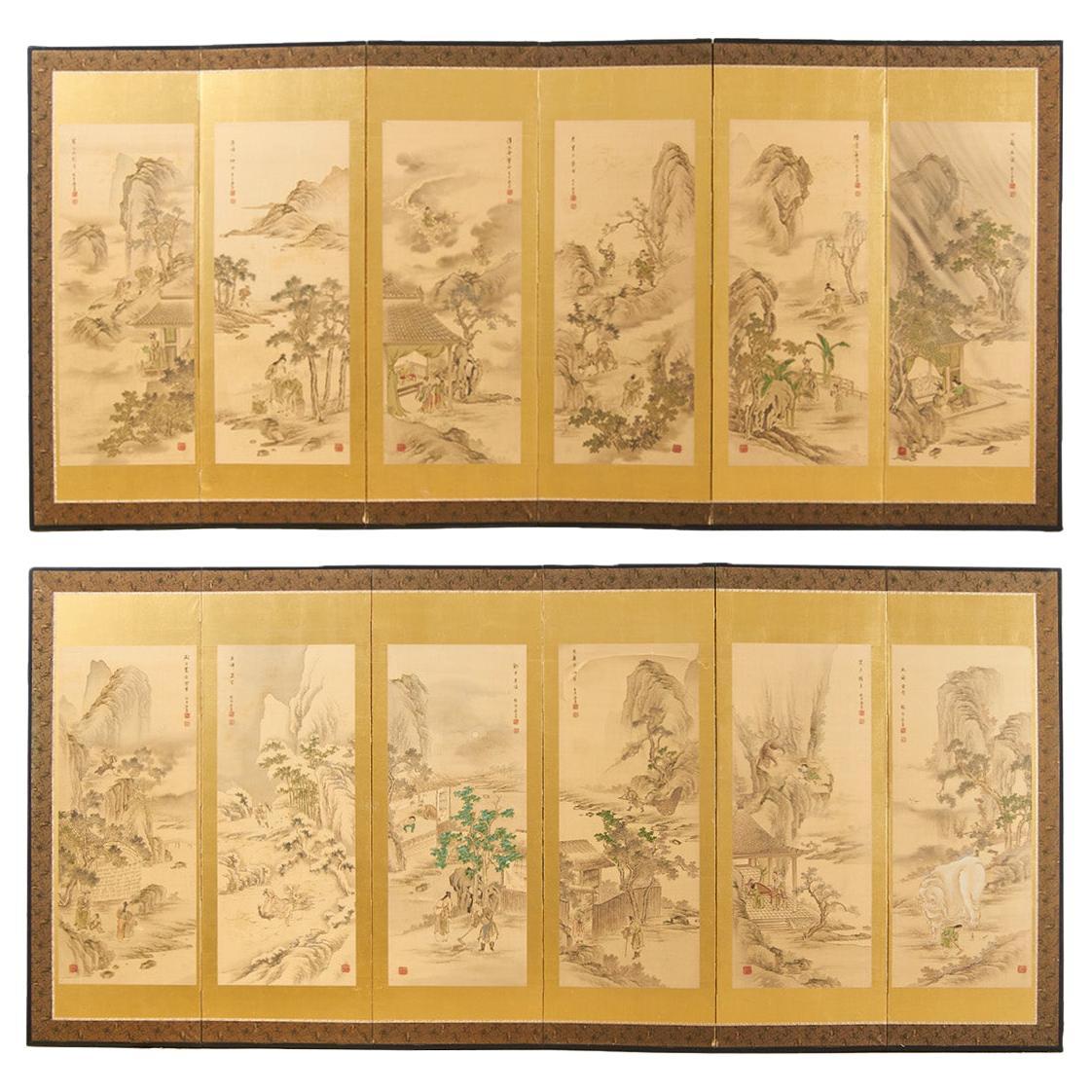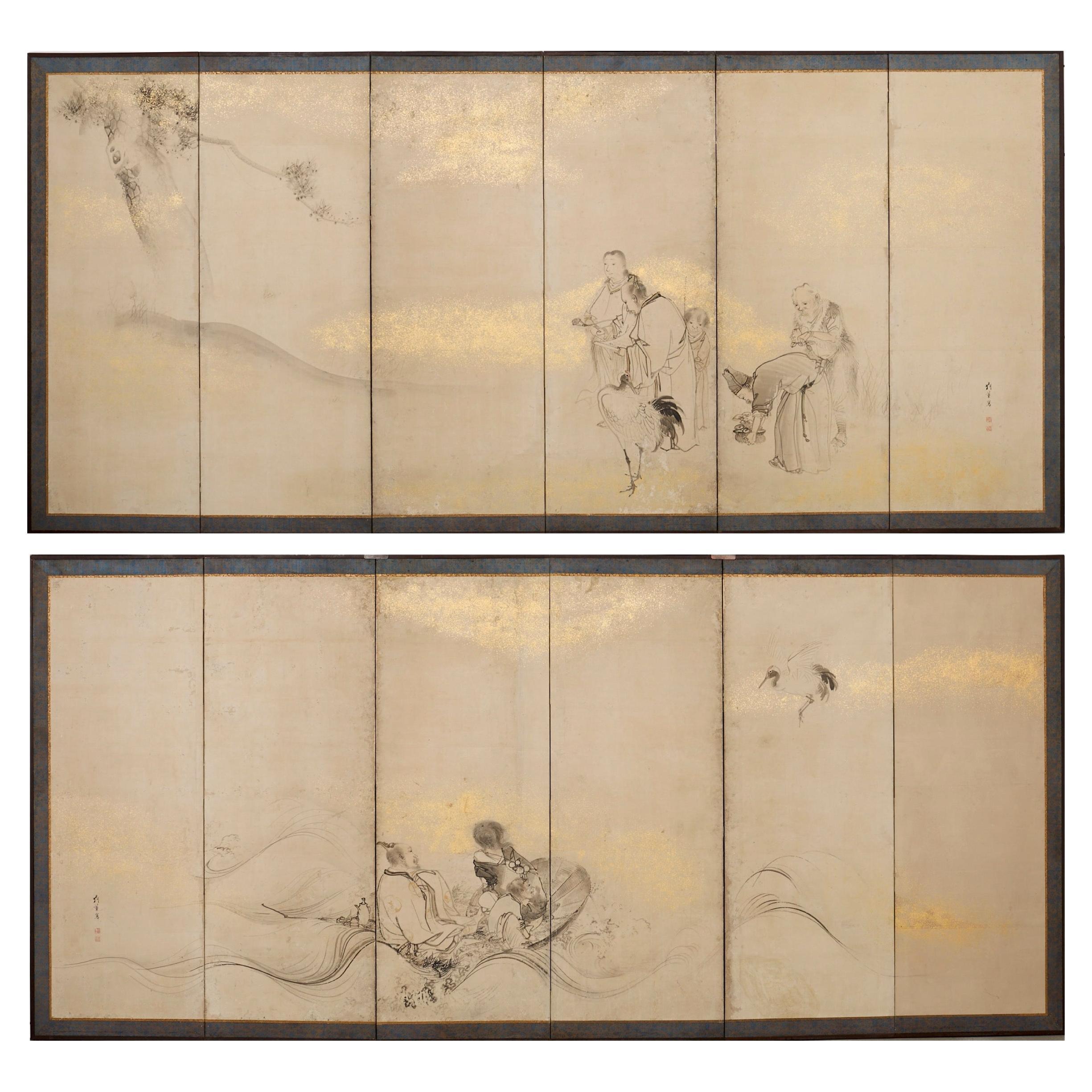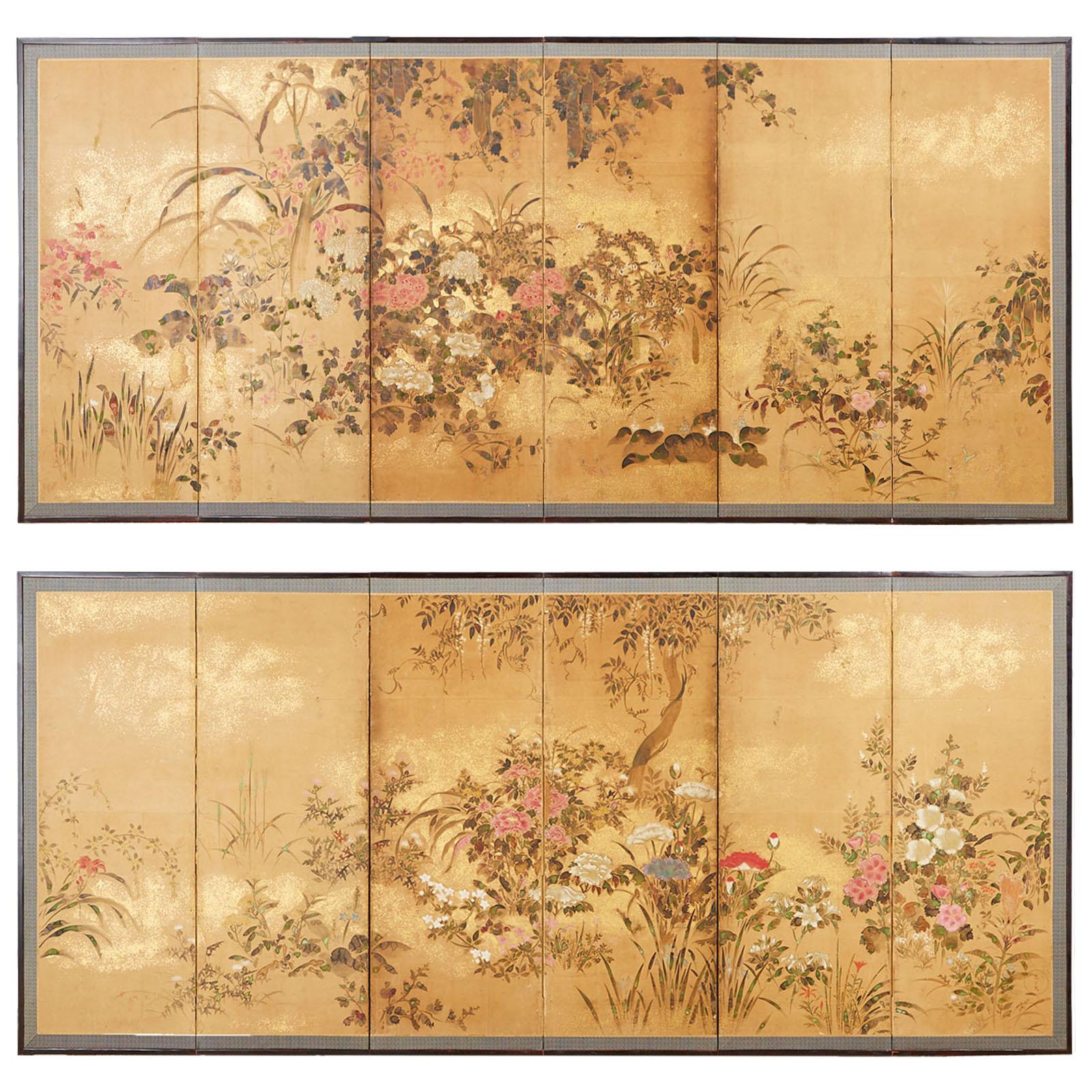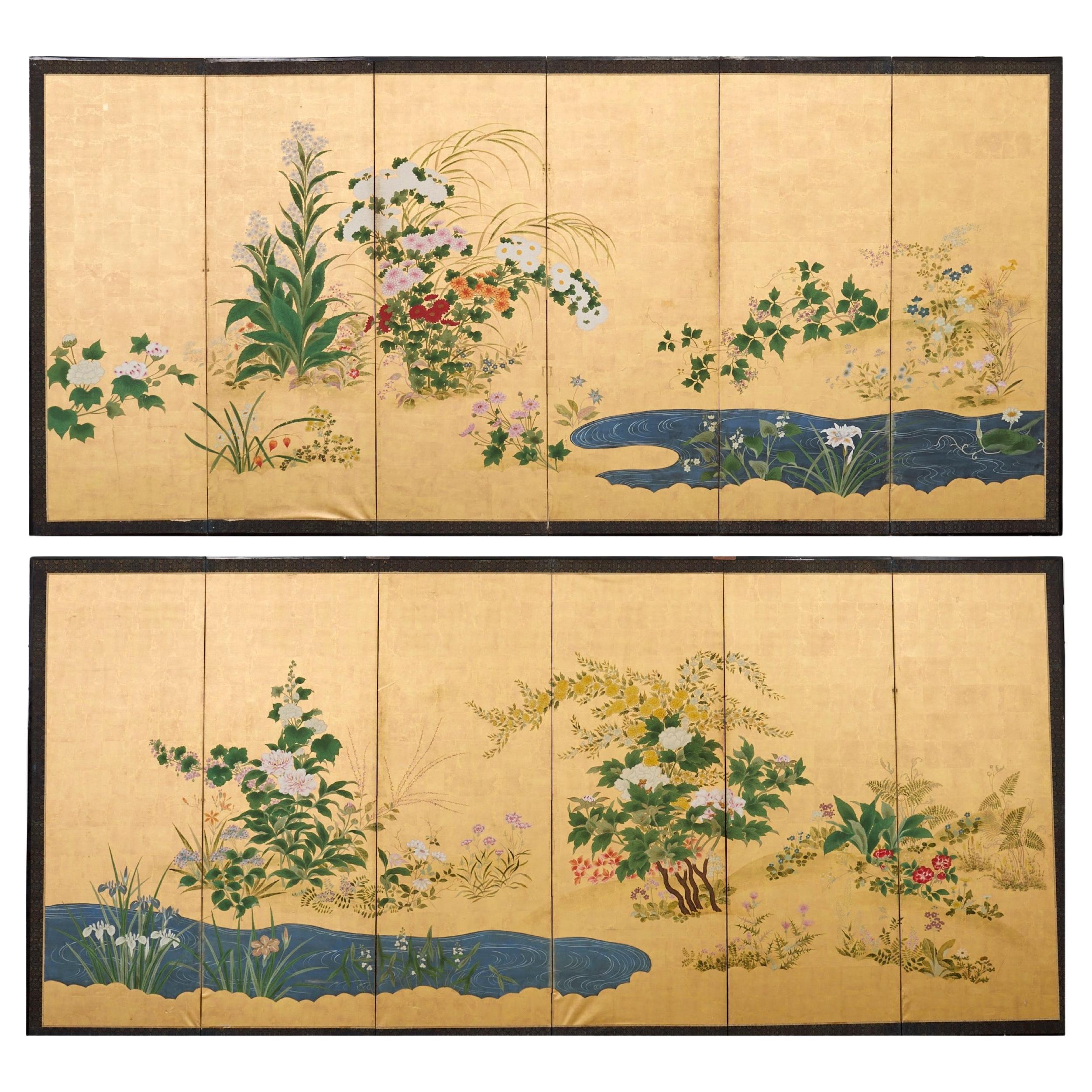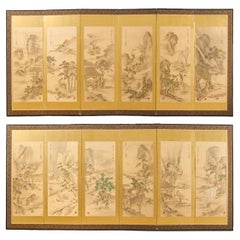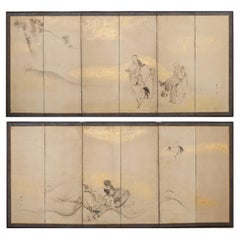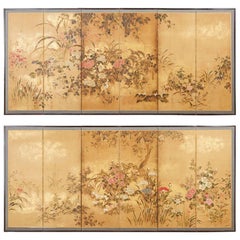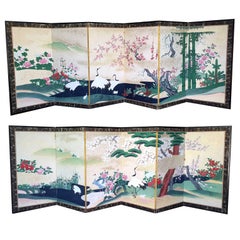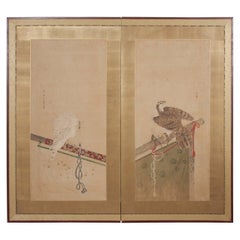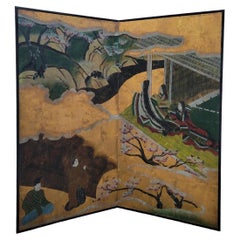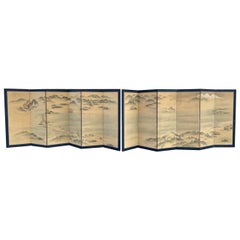Items Similar to Pair of Japanese Edo/Tokugawa Screens Tale of Heiki
Video Loading
Want more images or videos?
Request additional images or videos from the seller
1 of 22
Pair of Japanese Edo/Tokugawa Screens Tale of Heiki
$6,800per set
£5,231.01per set
€6,071.72per set
CA$9,589.62per set
A$10,741.99per set
CHF 5,642.08per set
MX$130,619.16per set
NOK 71,447.18per set
SEK 67,822.59per set
DKK 45,315.59per set
About the Item
Monumental pair of late 18th century Japanese Edo/Tokugawa period byobu screens depicting the battles between Taira and Minamoto. The screens have six panels each with individual scenes from the tale of Heiki. Each grand screen measures over 12 feet wide with highly intricate and colorful painted images. Beautifully crafted with natural color pigments on mulberry paper. The scenes are set into black lacquer ebonized frames with dramatic gold leaf square borders. The paintings have had repainted areas and later additions to the originals with bold blue tones, waves, and lovely green shades of the hillsides. Sold as a pair from an estate in Beverly Hills, CA.
- Dimensions:Height: 67 in (170.18 cm)Width: 148.5 in (377.19 cm)Depth: 0.75 in (1.91 cm)
- Sold As:Set of 2
- Style:Edo (Of the Period)
- Materials and Techniques:
- Place of Origin:
- Period:
- Date of Manufacture:Late 18th/Early 19th Century
- Condition:Repaired: Later repairs and repainted areas. Wear consistent with age and use. Beautifully crafted with age appropriate wear, fading, chips, scuffs, and small losses on finish that commensurate age and use as seen in photos. Painted scenes have vivid color with light stains. Majority of wear is on frames and gilt border matting.
- Seller Location:Rio Vista, CA
- Reference Number:1stDibs: LU1555242108212

About the Seller
5.0
Erin Lane Estate is based in the San Francisco Bay Area, and its team of furniture restorers, art curators, professional appraisers and Asia specialists sources prime vintage and antique furniture from the finest estates in Northern and Southern California. Erin Lane Estate specializes in Hollywood Regency, McGuire, Chinese and Japanese pieces.
Diamond Seller
Premium sellers with a 4.7+ rating and 24-hour response times
Established in 2000
1stDibs seller since 2015
3,013 sales on 1stDibs
Typical response time: 1 hour
- ShippingRetrieving quote...Shipping from: Rio Vista, CA
- Return Policy
Authenticity Guarantee
In the unlikely event there’s an issue with an item’s authenticity, contact us within 1 year for a full refund. DetailsMoney-Back Guarantee
If your item is not as described, is damaged in transit, or does not arrive, contact us within 7 days for a full refund. Details24-Hour Cancellation
You have a 24-hour grace period in which to reconsider your purchase, with no questions asked.Vetted Professional Sellers
Our world-class sellers must adhere to strict standards for service and quality, maintaining the integrity of our listings.Price-Match Guarantee
If you find that a seller listed the same item for a lower price elsewhere, we’ll match it.Trusted Global Delivery
Our best-in-class carrier network provides specialized shipping options worldwide, including custom delivery.More From This Seller
View AllPair of Japanese Edo Six Panel Screens the Seven Sages
Located in Rio Vista, CA
Fantastic pair of 19th century Japanese late Edo/early Meiji period six-panel screens titled The seven sages of the bamboo grove. The Kano school screens...
Category
Antique 19th Century Japanese Edo Paintings and Screens
Materials
Brass, Gold Leaf
Pair of Japanese Taisho Period Screens Paragons of Filial Piety
Located in Rio Vista, CA
Impressive pair of Japanese screens from the Taisho period meiji. Each six-panel screen depicts an image from the 24 paragons of filial piety ...
Category
20th Century Japanese Taisho Paintings and Screens
Materials
Brass, Gold Leaf
Pair of 18th Century Japanese Edo Screens of Chinese Immortals
Located in Rio Vista, CA
Mesmerizing pair of late 18th/early 19th century Japanese Edo period byobu screens by Shibata Gito (Japanese 1780-1819). The paintings depict Chinese immortals in a dreamy landscape....
Category
Antique 18th Century Japanese Edo Paintings and Screens
Materials
Silk, Wood, Paper
Pair of Japanese Edo Rimpa School Screens after Tawaraya Sōtatsu
Located in Rio Vista, CA
Impressive pair of 17th century Japanese Edo period Rinpa school screens made in the manner and style of Autumn Grasses by Tawaraya Sōtatsu (1570-1640). Beautifully decorated with wi...
Category
Antique 17th Century Japanese Edo Paintings and Screens
Materials
Gold Leaf
Pair of Japanese Meiji Screens Blossoms of Spring, Summer and Autumn
Located in Rio Vista, CA
Amazing pair of late 19th/early 20th century Japanese Meiji period byobu screens depicting flowering plants and blossoms of the spring, summer, and autumn. Painted in the Nihonga sch...
Category
Antique 19th Century Japanese Meiji Paintings and Screens
Materials
Brass, Gold Leaf
19th Century Japanese Edo Screen Kano School Garden Terrace
Located in Rio Vista, CA
Fantastic 19th century Japanese Edo/Tokugawa period two-panel byobu screen featuring Chinese children frolicking on a garden terrace with a pavilion and large pine tree. Made in the ...
Category
Antique 19th Century Japanese Edo Paintings and Screens
Materials
Brass, Gold Leaf
You May Also Like
Pair of Rare Antique Japanese Folding Screens with Provenance
Located in Atlanta, GA
An amazing pair of matching antique Japanese folding screen predating 1812-1813, most likely from Kano School. Six panels each depict C...
Category
Antique 1810s Japanese Japonisme Paintings and Screens
Materials
Brass
Japanese Edo Period Two-Panel Screen
Located in Stamford, CT
A Japanese Edo Period two panel folding screen with white and brown hawks of ink and color on paper.
Category
Antique Mid-19th Century Japanese Edo Paintings and Screens
Materials
Paper
Japanese Two-Panel Kanō Screen -Tale of Genji & Cherry Blossoms
Located in Greenwich, CT
Japanese Two-Panel Screen Kanō school, depicting a scene from the Tale of Genji , with various noble ladies and gentlemen in a landscape of cherry Blossoms - ink, colors and gold ...
Category
Antique Late 19th Century Japanese Meiji Paintings and Screens
Materials
Wood, Paper
Pair of 19th Century Japanese Screens
Located in Bagshot, GB
A pair of large 19th century Japanses Screens of Japanese scenery.
The screens also come with a wooden crate which would have been built for them at a later date in order to move ...
Category
Antique 19th Century Asian Other Decorative Art
Materials
Paper
$3,624 Sale Price / set
30% Off
19th Century Japanese Screen Pair. Flowers & Birds of the Four Seasons
Located in Kyoto, JP
Flowers & Birds of the Four Seasons
Pair of six-fold Japanese Screens. Ink, color, gofun and gold on paper.
Second half of the 19th Centur...
Category
Antique Late 19th Century Japanese Meiji Paintings and Screens
Materials
Wood, Paper
Japanese Screen Painting, Circa 1700 'Tales of Ise' by Tosa Mitsusuke
By Tosa Mitsusuke 1
Located in Kyoto, JP
A six-fold Japanese screen by Tosa Mitsusuke (1675-1710), Japan 17th-18th century, Edo period.
The signature reads Shoroku-i ge Tosa sa Konoe Shogen Mit...
Category
Antique Late 17th Century Japanese Edo Paintings and Screens
Materials
Gold Leaf
More Ways To Browse
Edo Wood
18th Century Hand Screen
18th Century Asia Brass
Ebonized Japanese
Asian Screens Green
Green Japanese Screen
Pair Of Japanese Screens
Antique Japanese Lacquer Screens
Edo Screen Gold
Japanese Byobu
Byobu Screens
Antique Japanese Black Lacquer Panels
Byobu Panel
Japanese Screens Byobu
18th Century Japanese Screens
Byobu Japanese Screen Painting
Lacquer Six Panel Screen
19th Century Japanese Lacquer Screen
